 |
| Captain Jeremy riding the rooster tale. |
 |
| Katie and Genevieve. |
 |
| Genevieve and Katie. |
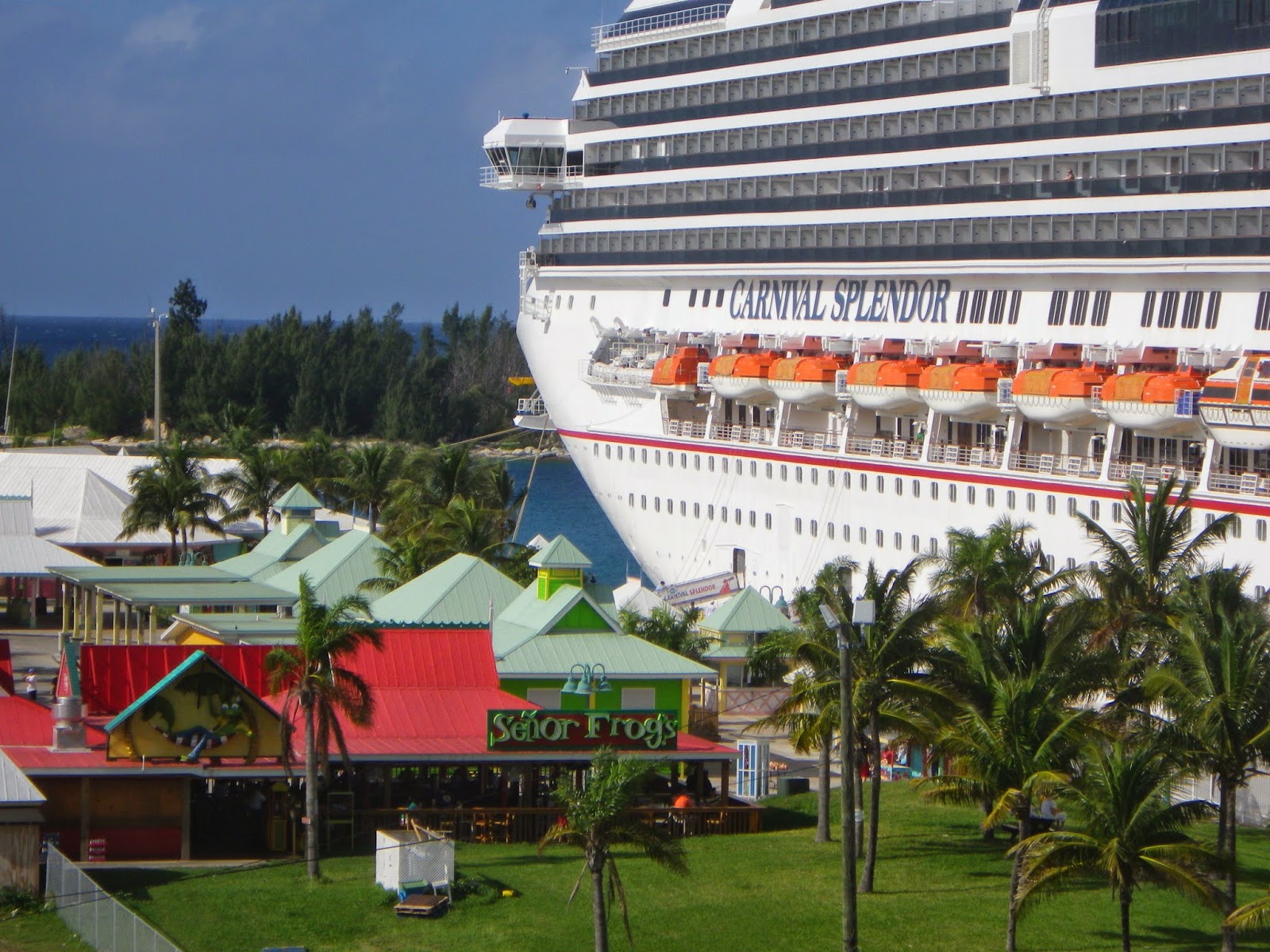 |
| Senor Frogs -- unfortunately, many visitors to the Bahamas never make it past this point on the itinerary. |
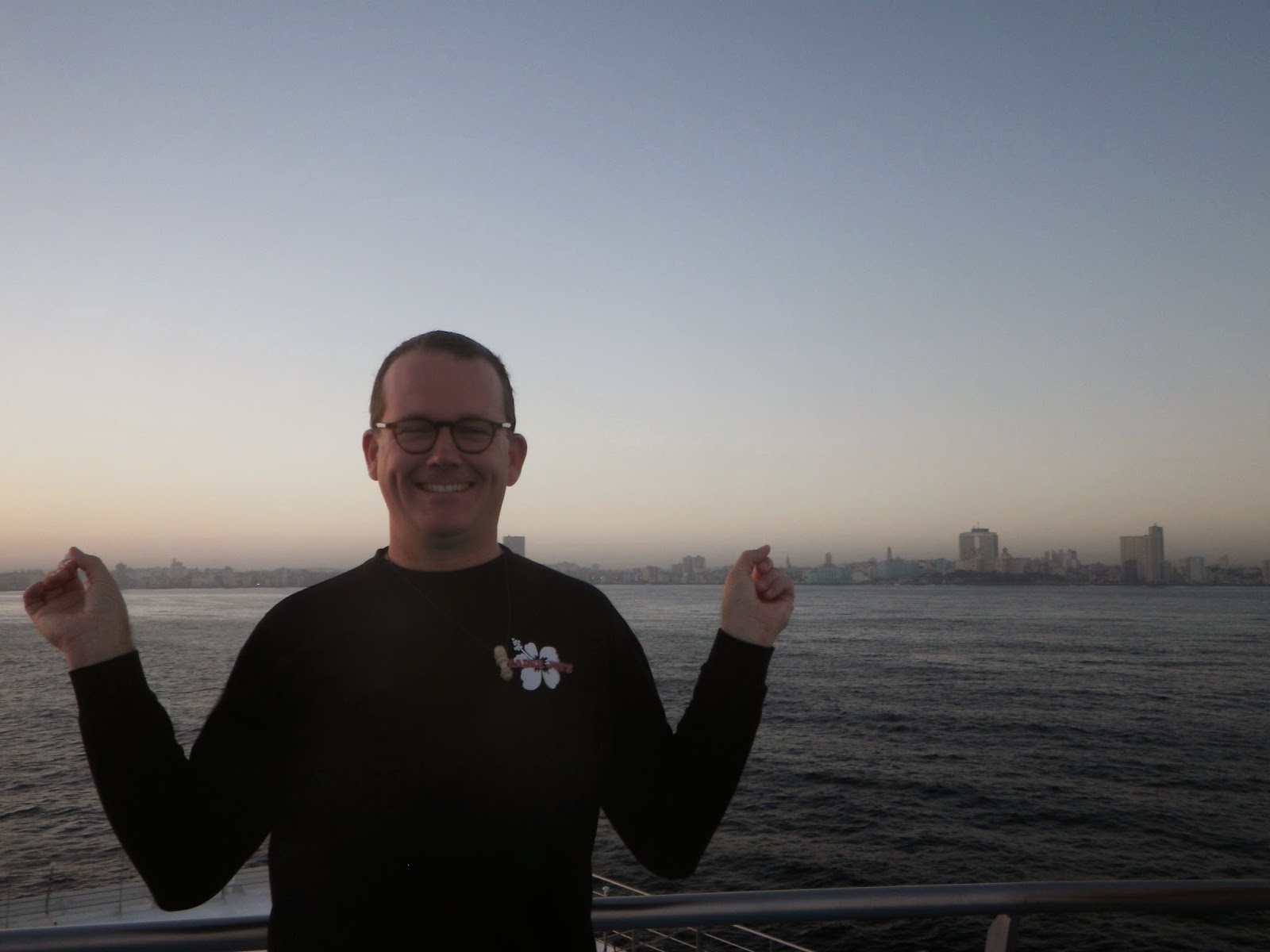 |
| Early dawn arrival in Havana, Cuba. |
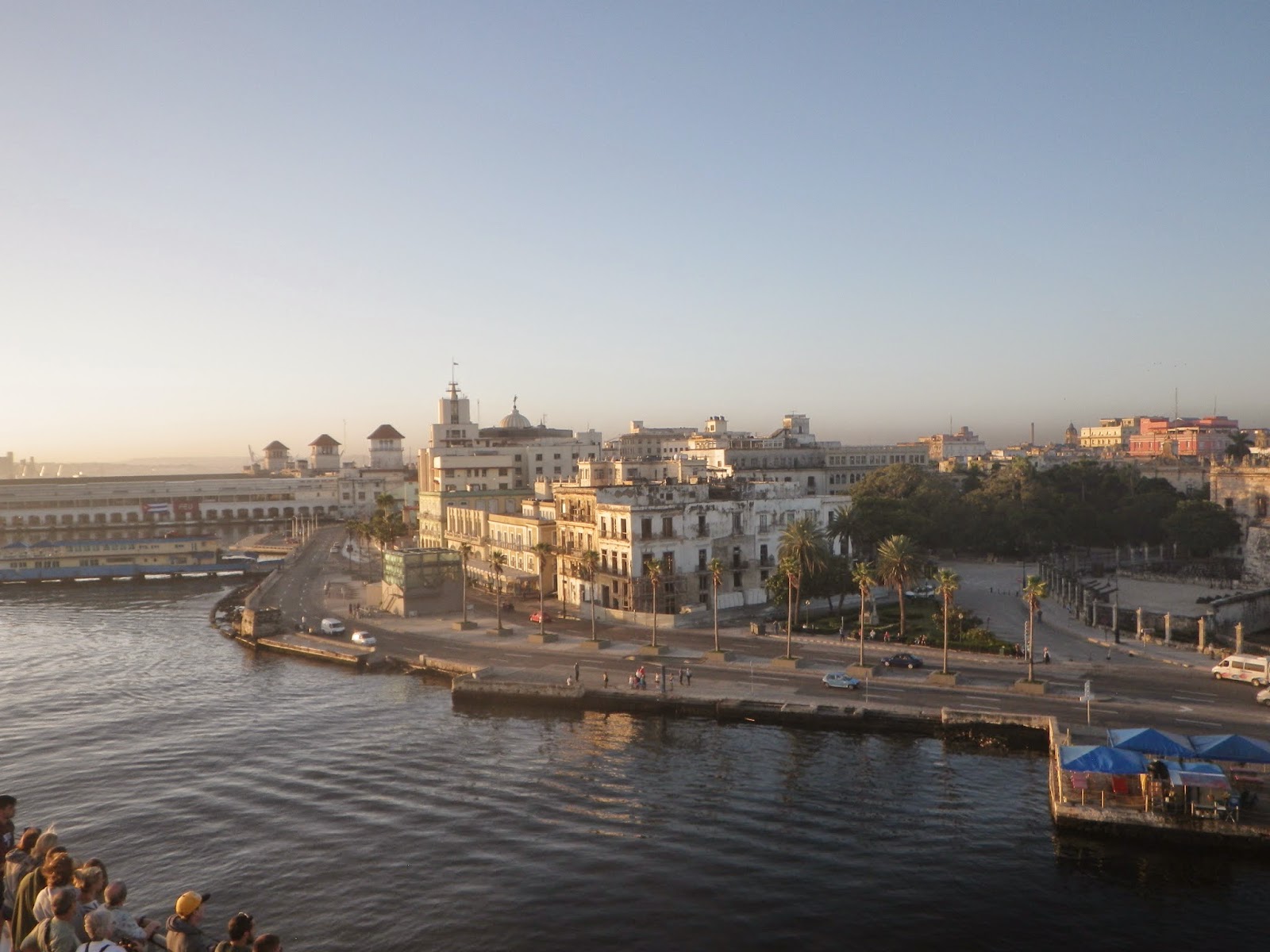 |
| Entry to the harbor. |
 |
| Looking to the right of the harbor as we enter. |
 |
| Old buildings in a state of semi-repair. |
 |
| Mercer at the University of Havana. |
 |
| University students and faculty gave us the warmest welcome of the whole trip. A full day of speeches, dances, singing, lectures, and food. |
 |
| The Alma Mater on the steps up to the University of Havana. |
 |
| Horse-drawn wagon in traffic behind an old Russian car: you got used to this sight very quickly. |
 |
| Most Americans think of Cuba as "stepping back in time" to 1959. True enough, but parts of it were like stepping back in time to 1909, or even 1859. |
 |
| The obligatory old classic American car. You did see a lot of these, but they were not the majority of cars on the road. |
 |
| Another traffic picture: horse-drawn wagon, truck, older cars and newer Russian or Asian cars. |
 |
| In the plaza of Saint Francis of Assisi, just off the harbor. |
 |
| What Cuba looks like in its nicest areas. |
 |
| Shrimp in boiling butter with garlic. |
 |
| Everyone told us Cuban food would be or was terrible. Our experience was completely the opposite. |
 |
| Cuban wall art was very "POP"py and fairly predictable, but fun. |
 |
| Mojito, Cuba Libre, they're all good with Havana Club rum. $3 a bottle inside Cuba, but CD26 for the same bottle outside of Cuba, like Toronto. THAT's capitalism! |
 |
| Street musicians who refused to let us give them a tip: "You have paid us by listening and dancing to our music. It is we who owe you." Surreal. |
 |
| Lots of murals, wall art, and pastoral paintings of Fidel and other Cuban leaders. |
 |
| I didn't notice the flavor, just that it wasn't Coca-Cola. |
 |
| Two journalism students who wanted to take a picture with me. |
 |
| At the Guyabita del Pinar production facility, a Cuban specialty drink, like a rum, but different. |
 |
| Very small production facility, with filling done by small machine and labeling done by hand. |
 |
| The vats at the distillery. |
 |
| This is the woman whose job it is to prep the little Guyabita fruits, one of which goes into each bottle. |
 |
| This is the Guyabita fruit, without which you can't make the product. |
 |
| The finished product, also about $3 per bottle. |
 |
| The label. |
 |
| One of my students and me on the field trip. |
 |
| An oxen as local individual transport. |
 |
| The cuban cigars and cigarillos on display at a local vendor. |
 |
| Mountainous region of Pinar del Rio. |
 |
| The painted cliff face of one of the mountains, a sort of interesting mix of pseudo-aborigine and Keith Haring pop art. |
 |
| Map of the region, the westernmost state of Cuba. |
 |
| Pen is pointing to the area we were in. |
 |
| Freshly woven baskets. |
 |
| The basket weaver. |
 |
| Another local oxen, that you could pay to sit on or ride. |
 |
| At the tobacco farm and plantation. |
 |
| Young tobacco leaves |
 |
| Drying and curing inside the barns. |
 |
| The tobacco leaf in its "ready to roll" state. |
 |
| View of the tobacco field and drying barn in background. |
 |
| Cohiba swag and samples. |
 |
| Multipacks, sold cheaply. |
 |
| The sizing mechanism. |
 |
| Rolling mechanism. |
 |
| Our police escorts, very happy to pose for photographs. |
 |
| Posters for The Cuban Five, or Cinco Padres, were all over the country. We asked our hosts equally uncomfortable questions about Alan Gross and they gave some interesting answers. |
 |
| At the bay where the old man met the sea. This is Cojimar, where Hemingway docked the Pilar, his fishing vessel. |
 |
| The platform and rotunda with the Hemingway bust. |
 |
| The Hemingway Park sign. |
 |
| The bust of Hemingway is itself an interesting story. It is made of melted-down old propeller blades, donated by the fishermen who knew him as one of their own. |
 |
| The fort/castle in Cojimar is not open for visitation, and currently seems to be occupied by a somewhat possessive homeless man. Then again, having one's own castle hardly seems homeless. |
 |
| The guest cottage at Finca Vigia, Hemingway's large and lovely hilltop estate. |
 |
| Finca Vigia under the tree. |
 |
| Entrance to Finca Vigia. You are no longer allowed inside, because too many tourists were stealing too many things. But the windows and doors are open and you may lean in and take pictures. |
 |
| Sitting room. |
 |
| This is the bell outside the house. It did not toll for thee, or me. It was silent the whole time. |
 |
| The thing you notice in every room are books. |
 |
| And bookshelves. |
 |
| He was not only a great writer, but a great reader. |
 |
| Open plan living space. |
 |
| Bullfight! |
 |
| Hemingway's desk. |
 |
| Scholars can request permission to go inside, and peruse his actual books, in order to do research. |
 |
| The view from his lookout tower. |
 |
| Another view in a different direction from the lookout tower. |
 |
| Books in the bathroom! |
 |
| Books books everywhere. |
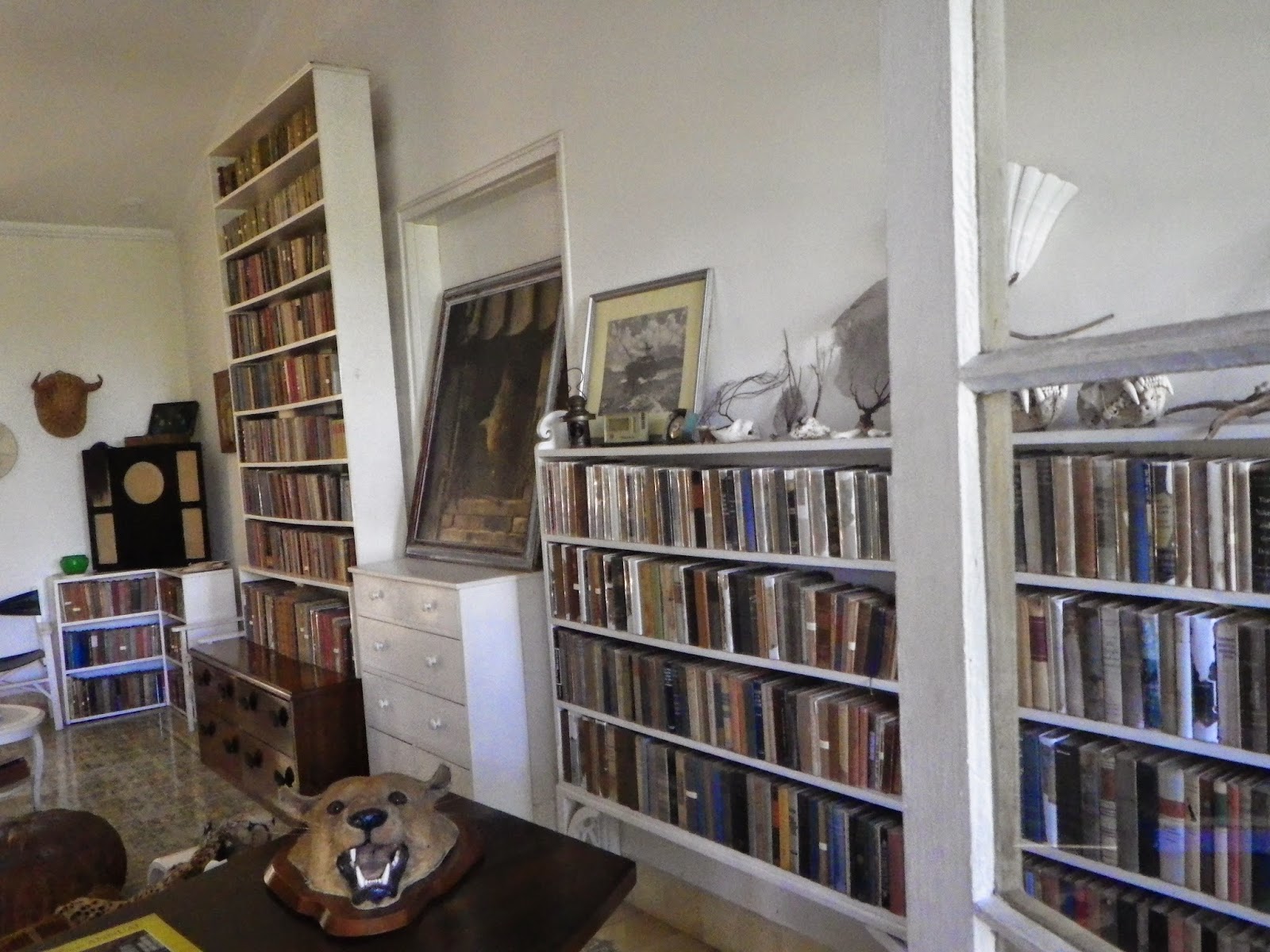 |
| And more books. |
 |
| The dining room. |
 |
| The art and animal heads on every wall are all you need to see to know that he really was a big game hunter. |
 |
| The walkway to Hemingway's pool and boathouse. |
 |
| The pool, now empty. |
 |
| Pet cemetery |
 |
| The Pilar |
 |
| The famous boat. |
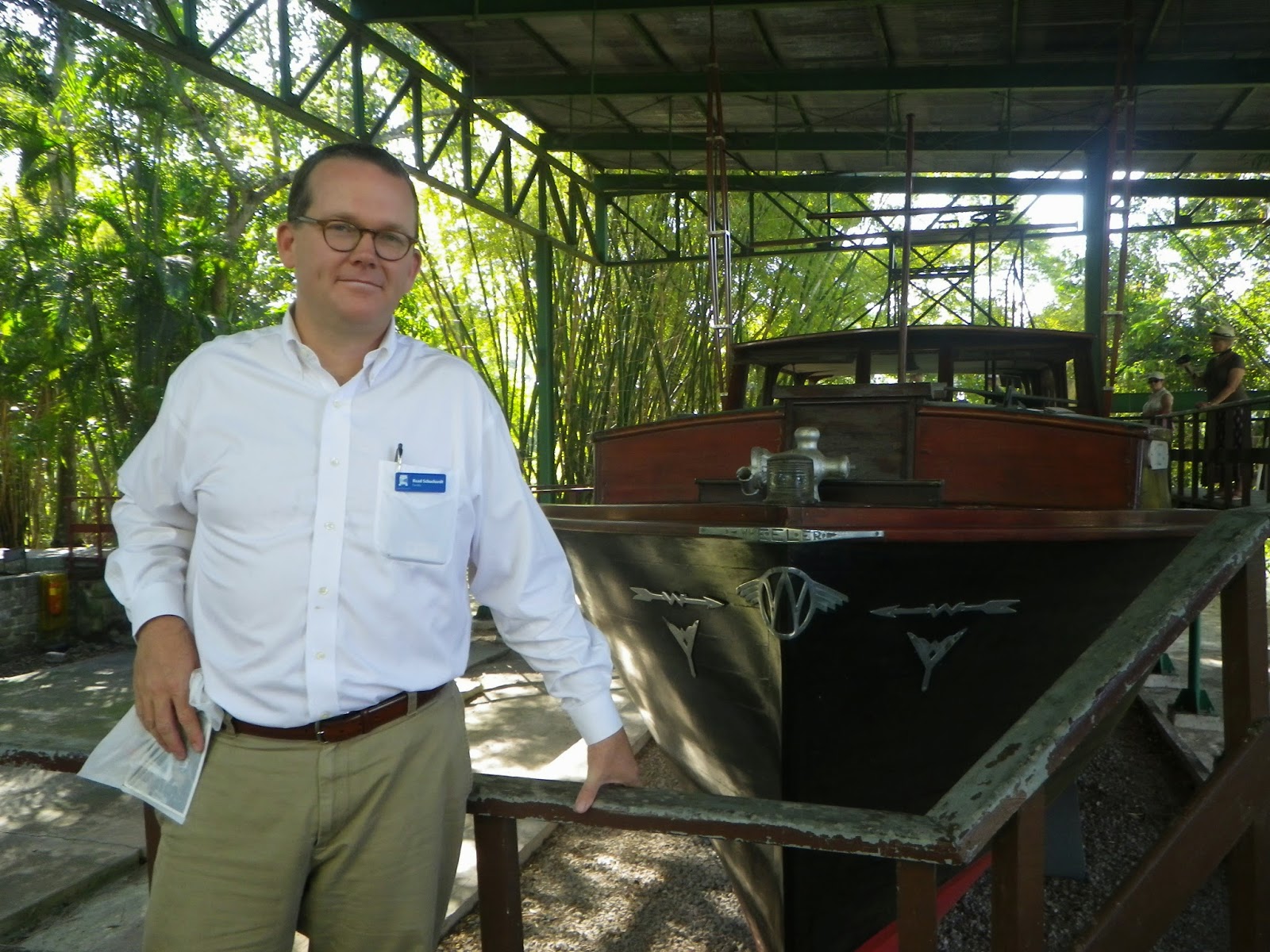 |
| Professor Schuchardt standing in front of The Pilar. Hemingway died within two years of leaving Cuba. |
 |
| A selection of fine rum... |
 |
| With which to make many fine drinks, one of which is called the Hemingway, and another of which, legend has it, Hemingway helped create (the Daiquiri). |
 |
| The old man, and Papa's statue, and a picture of Papa and Fidel. |
 |
| Bar Floridita is called "The Cradle of the Daiquiri" but I didn't try one -- too expensive! |
 |
| Hemingway pictures all over the walls of the Bar Floridita. |
 |
| Still, it was a pretty bar. |
 |
| If there was another brand of rum available, I never saw it. |
 |
| External shot of the Bar Floridita. |
 |
| The sign up close, for all you graphic design geeks out there. |
 |
| The little coconut-shaped taxi cabs all over town. |
 |
| Cuban folk art itself was kind of fascinating. In this case I can't help but wonder if the artist isn't working off a theme of Fibonacci numbers. |
 |
| Here is Don Juan on a chicken. |
 |
| Here is Cuba in symbolic form. |
 |
| I don't smoke, but I did enjoy collecting a few of the cigar box art insert pieces. |
 |
| Vampires of Havana, my favorite "clever" poster. |
 |
| La Bella Del Alhambra, a very nice Art Deco style poster. |
 |
| These are Cuban cars: new Korean, Old American, old Russian makes. |
 |
| Back on ship, after picking up the family in the Bahamas, we had our final celebration dinner and dressed up all fancy and had to have a reservation for our tables. Adler and Jasper. |
 |
| Genevieve and Oliver looking swanky. |
 |
| Adler lasted about half the night, then fell asleep after only one slice of pizza. |
 |
| Last night celebration in the Faculty Lounge, with colleagues and new friends. |
 |
| Rachel and Genevieve above deck on the final morning, December 16, 2013, as we pull into Fort Lauderdale (Port Everglades), Florida. |
 |
| Walker getting his flag signed. |
 |
| Students and staff all watching in anticipation of the final docking. |
 |
| Jane, the wonderful child's program coordinator. |
 |
| Farewell to my cabin card, and farewell to cabin 4099. The cards would have been great mementos, but had to be returned to the Purser's Desk upon departure. |





